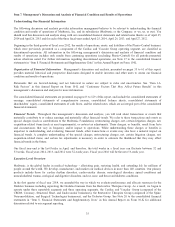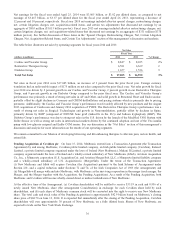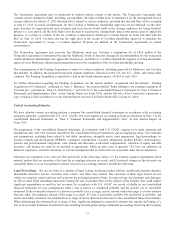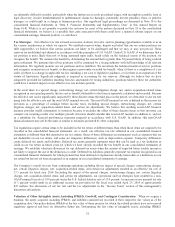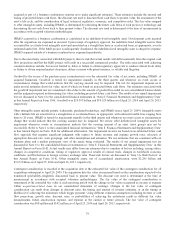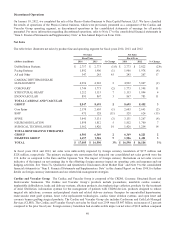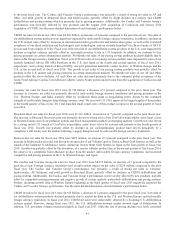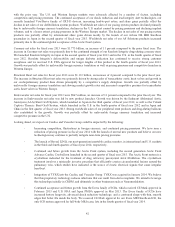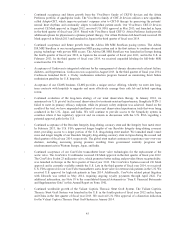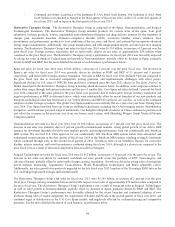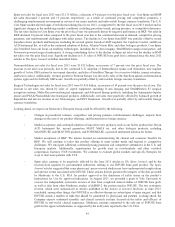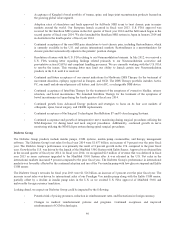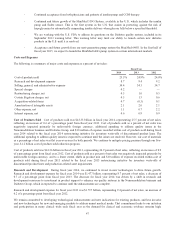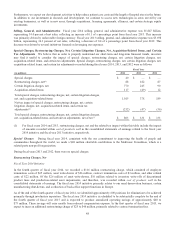Medtronic 2014 Annual Report Download - page 46
Download and view the complete annual report
Please find page 46 of the 2014 Medtronic annual report below. You can navigate through the pages in the report by either clicking on the pages listed below, or by using the keyword search tool below to find specific information within the annual report.are inherently difficult to predict, particularly when the matters are in early procedural stages, with incomplete scientific facts or
legal discovery; involve unsubstantiated or indeterminate claims for damages; potentially involve penalties, fines, or punitive
damages; or could result in a change in business practice. Our significant legal proceedings are discussed in Note 18 to the
consolidated financial statements in “Item 8. Financial Statements and Supplementary Data” in this Annual Report on
Form 10-K. While it is not possible to predict the outcome for most of the matters discussed in Note 18 to the consolidated
financial statements, we believe it is possible that costs associated with them could have a material adverse impact on our
consolidated earnings, financial position, or cash flows.
Tax Strategies Our effective tax rate is based on income, statutory tax rates, and tax planning opportunities available to us in
the various jurisdictions in which we operate. We establish reserves when, despite our belief that our tax return positions are
fully supportable, we believe that certain positions are likely to be challenged and that we may or may not prevail. These
reserves are established and adjusted in accordance with the principles of U.S. GAAP. Under U.S. GAAP, if we determine that a
tax position is more likely than not of being sustained upon audit, based solely on the technical merits of the position, we
recognize the benefit. We measure the benefit by determining the amount that is greater than 50 percent likely of being realized
upon settlement. We presume that all tax positions will be examined by a taxing authority with full knowledge of all relevant
information. We regularly monitor our tax positions and tax liabilities. We reevaluate the technical merits of our tax positions
and recognize an uncertain tax benefit, or derecognize a previously recorded tax benefit, when (i) there is a completion of a tax
audit, (ii) there is a change in applicable tax law including a tax case or legislative guidance, or (iii) there is an expiration of the
statute of limitations. Significant judgment is required in accounting for tax reserves. Although we believe that we have
adequately provided for liabilities resulting from tax assessments by taxing authorities, positions taken by these tax authorities
could have a material impact on our effective tax rate in future periods.
In the event there is a special charge, restructuring charge, net, certain litigation charge, net, and/or acquisition-related items
recognized in our operating results, the tax cost or benefit attributable to that item is separately calculated and recorded. Because
the effective rate can be significantly impacted by these discrete items that take place in the period, we often refer to our tax rate
using both the effective rate and the non-GAAP nominal tax rate. The non-GAAP nominal tax rate is defined as the income tax
provision as a percentage of earnings before income taxes, excluding special charges, restructuring charges, net, certain
litigation charges, net, acquisition-related items, and certain tax adjustments. We believe this resulting non-GAAP financial
measure provides useful information to investors because it excludes the effect of these discrete items so that investors can
compare our recurring results over multiple periods. Investors should consider this non-GAAP measure in addition to, and not
as a substitute for, financial performance measures prepared in accordance with U.S. GAAP. In addition, this non-GAAP
financial measure may not be the same or similar to measures presented by other companies.
Tax regulations require certain items to be included in the tax return at different times than when those items are required to be
recorded in the consolidated financial statements. As a result, our effective tax rate reflected in our consolidated financial
statements is different than that reported in our tax returns. Some of these differences are permanent, such as expenses that are
not deductible on our tax return, and some are temporary differences, such as depreciation expense. Temporary differences
create deferred tax assets and liabilities. Deferred tax assets generally represent items that can be used as a tax deduction or
credit in our tax return in future years for which we have already recorded the tax benefit in our consolidated statements of
earnings. We establish valuation allowances for our deferred tax assets when the amount of expected future taxable income is
not likely to support the use of the deduction or credit. Deferred tax liabilities generally represent tax expense recognized in our
consolidated financial statements for which payment has been deferred or expense has already been taken as a deduction on our
tax return but has not yet been recognized as an expense in our consolidated statements of earnings.
The Company’s overall tax rate from continuing operations including the tax impact of special charges, restructuring charges,
net, certain litigation charges, net, acquisition-related items, and certain tax adjustments resulted in an effective tax rate of
17.3 percent for fiscal year 2014. Excluding the impact of the special charges, restructuring charges, net, certain litigation
charges, net, acquisition-related items, and certain tax adjustments, our operational and tax strategies have resulted in a non-
GAAP nominal tax rate of 18.0 percent versus the U.S. federal statutory rate of 35.0 percent. An increase in our nominal tax rate
of 1 percent would result in an additional income tax provision for the fiscal year ended April 25, 2014 of approximately
$47 million. See discussion of our tax rate and the tax adjustments in the “Income Taxes” section of this management’s
discussion and analysis.
Valuation of Other Intangible Assets, Including IPR&D, Goodwill, and Contingent Consideration When we acquire a
business, the assets acquired, including IPR&D, and liabilities assumed are recorded at their respective fair values as of the
acquisition date. Our policy defines IPR&D as the fair value of those projects for which the related products have not received
regulatory approval and have no alternative future use. Determining the fair value of intangible assets, including IPR&D,
38









